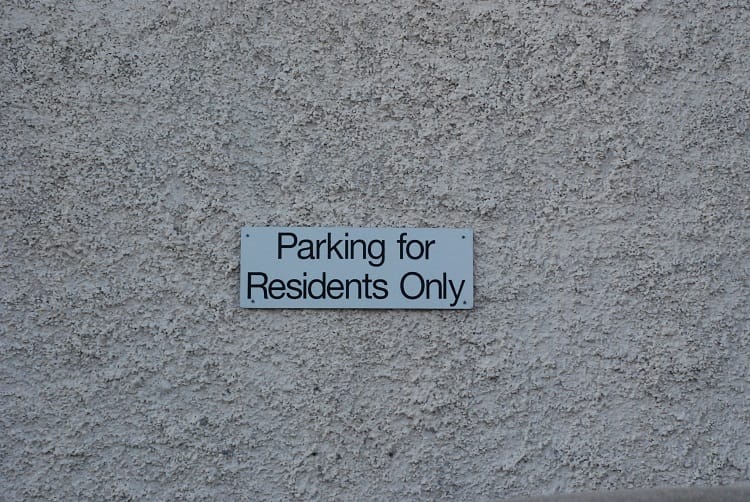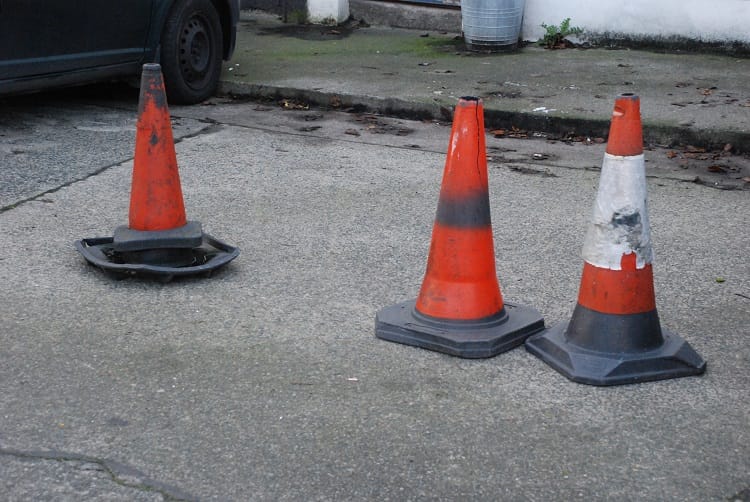What’s the best way to tell area residents about plans for a new asylum shelter nearby?
The government should tell communities directly about plans for new asylum shelters, some activists and politicians say.
On a recent day, residents were using 97 traffic cones to reserve the street parking spaces in front of their homes, in an effort to keep commuters and other outsiders from using them.

“You’ve to be up early to fight for your space,” says Hammond Street resident Margaret Carney. She’s been living in the Blackpitts area, in the south inner city, for decades, she says.
But in the last few years these narrow, terraced streets have become a battleground between residents and outsiders, who park their cars day in, day out, she says, free of charge.
“I marked this space last night,” says Carney, pointing to two orange traffic cones placed on the street outside her house.
She saves that space adjoining her car for her sister, who visits each day. “Still, I wasn’t sure if they’d be here this morning.”
St John’s Street and Hammond Street sit parallel to each other, bound in a loop by Greenville Parade, facing onto Blackpitts.
Last Friday morning, 97 traffic cones occupied these streets and sidewalks, the residents’ arsenal in their daily effort to protect what they see as their parking spaces.

Two “Parking for Residents Only” signs are tacked onto gable ends nearby. Down the street, ongoing construction interrupts the otherwise quiet neighbourhood.
Carney, in her late sixties, walks home from the shops with her wheelie bag. She continued the cone-placing practice after the couple who originally instigated it moved out of the area.
“The morning they left I took their cones,” she says.
It grew from there. Some cones are marked with house numbers. There’s the classic large traffic cone, the miniature version, and even smaller yellow cones, all strewn outside terraced houses or along footpaths rounding onto St John’s Street.
Some residents, Carney says, put them out “religiously” to fend off outside commuters who, she says, are “very cheeky” taking advantage of the area’s free parking.
“It’s gotten worse,” she says. “The residents feel we don’t get a look in unless we’re up bright and breezy.”
Kevin Murray, who lives nearby, agrees. He’s been living on Hammond Street his whole life. “When I was a kid here, there wasn’t one car on this road,” he says. “Nobody had cars then.”
As the city grew, though, so did the number of cars and the demand for parking.
Residents of these streets, however, don’t own the spaces outside their houses. They are essentially commandeering them.
But without another system in place to regulate parking – pay-and-display parking or residents’ permits – these cones aren’t going anywhere fast, even if there is no legal basis for their use.
“There is no parking scheme in place on [these streets],” according to a spokesperson for Dublin City Council. “Parking is free and available to all.”
Placing cones to block public space is not allowed, the spokesperson added, nor is there any legal basis for the “Parking for Residents Only” signs in the area, they said.
Among residents, increased development in the Blackpitts area has been a cause for concern for some time now. There’s a large, active construction site just a short way up towards Newmarket Square, where a redevelopment is planned.
Hammond Street’s Murray says that the daily influx of construction workers’ vehicles into the area has increased the battle for parking.

But the construction has also provided residents with their main weapon. Whether they’re stolen or donated from the building sites, no one is too keen to confirm the cones’ origins.
Carney says residents “accumulated them from builders”, while Murray says “they got them from all around the place”.
But on Friday and Monday mornings while I am visiting, no “outsiders” drive in to park their vehicles in the neighbourhood, perhaps because the cones are out in force, although Carney says residents are aware that the spaces they’re blocking off don’t belong to them.
“We don’t own the space,” she admits.
Parking problems persist in the inner city, as Labour Councillor Rebecca Moynihan sees it, because these streets simply weren’t built to accommodate cars.
This means that parking can be stressful and frustrating, but “we can either decide to plan a city around people, or we can decide to plan a city around the private car”, she says.
Moving forward, Dubliners should use public transport more, drive less, or possibly take up car-sharing, she says. The latter is something the National Transport Authority is currently looking at expanding.
As it stands, installing pay-and-display parking is the best course of action for small, older streets like those in Blackpitts, Moynihan reckons.
Residents, she says, would then be entitled to priority in the form of a resident’s permit. And, facing hourly charges, commuters might not park in the area all day.
For that to take off, though, 25 percent of residents must express interest in implementing the pay-and-display system, according to the council spokesperson.
After that, the residents would be balloted to see if a majority are in favour.
But, in Blackpitts, cones at the ready, residents are reluctant.
Carney reckons the 97 traffic cones will stand at the ready for the foreseeable future. Most residents, she says, have shown little or no interest in pay-and-display.
She chants, she says, pointing to the small shrine propped up in her living room. A Buddhist for 40 years, perhaps incantation can change things, she laughs.
Across the street, Murray says that, while residents may not be in favour of pay-and-display parking, it is a solution to the problem.
“That might sort the problem,” he says. “But until then people are just gonna put out cones.”
Local residents were told two years ago by the council that a resident’s permit costs €80 for two years under the pay-and-display system. (Residents’ permits currently cost €50 for one year and €80 for two years if you live in a house.)
They rejected that option as too expensive, opting instead for their cones, says Murray.
“They came around here two years ago. The council took all the cones and put them in the back of a truck,” says Murray. “A week later everyone had more cones.”